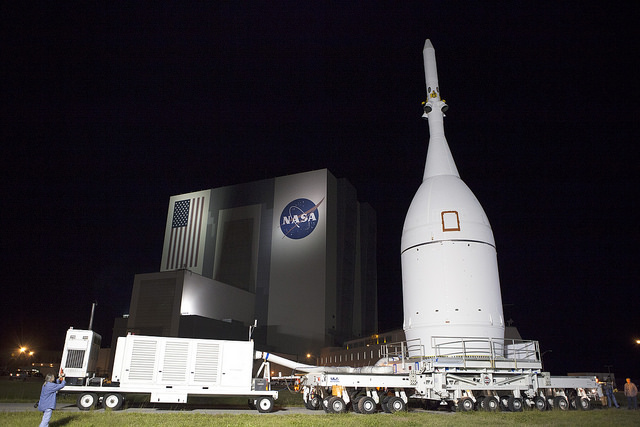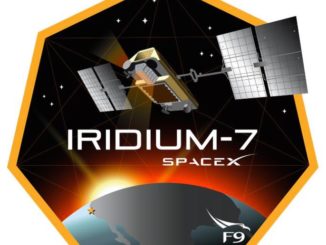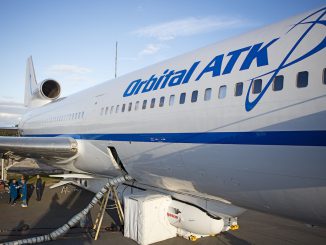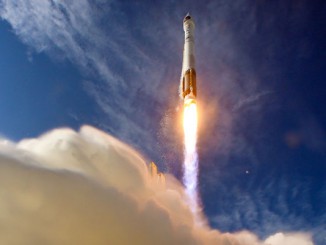
Orbital ATK has cinched $188 million in contracts to complete development of the Orion crew capsule’s needle-shaped launch abort system, resuming work stalled in the wake up a major shakeup of NASA’s human spaceflight program by the Obama administration in 2010.
Lockheed Martin, NASA’s prime contractor for the Orion program, awarded the contracts in two segments — one worth $90 million announced in April for the escape system’s attitude control motor, and another deal revealed Tuesday valued at $98 million for the launch abort motor itself.
The Orion capsule’s launch abort system would propel the spacecraft and its occupants away from a launch failure.
Orbital ATK won contracts to develop the abort system in 2007. The prime contract went to Orbital Sciences Corp., which selected ATK to supply the escape system’s solid-fueled abort and attitude control motors. Orbital Sciences selected Aerojet to build a jettison motor.
In an era of consolidation among big aerospace industry contractors, Orbital Sciences and ATK closed a merger in February to form one company — Orbital ATK. Aerojet’s parent company, GenCorp, acquired Pratt & Whitney Rocketdyne in 2013, creating Aerojet Rocketdyne.
Engineers tested the launch abort stack in a pad abort demonstration in New Mexico in May 2010, just before NASA and its contractors put most of the escape rocket’s development on hold.
Development of the abort system mostly halted after the 2010 pad abort test. The abort demo occurred months after the Obama administration canceled NASA’s Constellation program, which intended to return astronauts to the moon.
The Orion spacecraft had its origins in the Constellation program, and NASA kept the crew capsule project alive for the agency’s revamped space exploration initiative, which includes the Space Launch System, a gigantic new booster designed to send crews and massive cargo into deep space, and eventually to destinations such as an asteroid and Mars.
Due to funding restrictions, NASA re-ordered much of the Orion capsule’s development milestones, focusing first on maturing the craft’s propulsion system and heat shield for a four-and-a-half hour orbital test flight launched by a Delta 4-Heavy rocket in December.
NASA deferred further development of the capsule’s avionics, life support systems and abort motors until later in the program.
Orion’s abort system would activate during a launch emergency and fire a solid rocket motor generating 500,000 pounds of thrust to pull the capsule free of its rocket. Attitude control motors, powered by a solid propellant gas generator with eight thruster pressure release valves, would steer the capsule during the abort maneuver.
Development of the abort system’s Aerojet Rocketdyne jettison motor continued during the last few years. The device is required on all of Orion’s missions, including last year’s successful test flight on the Delta 4 rocket.
During the downtime, Orbital ATK worked at a “very reduced level” to explore design improvements on the abort system, according to Michael DiMauro, a company spokesperson.
Engineers conducted two single-valve test firings of the abort system’s attitude control motor to verify the minor design changes, DiMauro said.
The design work, testing and fabrication activities covered in Orbital ATK’s new abort system contracts will carry the escape rocket through the Orion spacecraft’s next three flights, the company said.
“Major milestones in the process include structural tests, loads tests, igniter open air tests, and motor static firing tests,” the company said in a statement. “These tests will ultimately qualify the abort motor for operational flight missions.”
Orbital ATK says its launch abort system work will occur at its facilities in Utah and Maryland.
Orion’s next flight is scheduled for 2018, when the capsule will blast off for the first time atop the Space Launch System.
A second Orion abort test in 2019 — to be launched from Cape Canaveral aboard a version of Orbital ATK’s Minotaur booster — will simulate the capsule’s escape from a rocket in flight, followed by the first SLS/Orion launch with astronauts on-board in 2021.
“Orbital ATK is proud to be a key contributor to the Orion program and to astronaut safety,” said Fred Brasfield, vice president of Orbital ATK’s NASA propulsion programs. “The benefit of using a solid launch abort motor is being able to transport the crew far from harm’s way in milliseconds, should the need arise.”
Email the author.
Follow Stephen Clark on Twitter: @StephenClark1.



